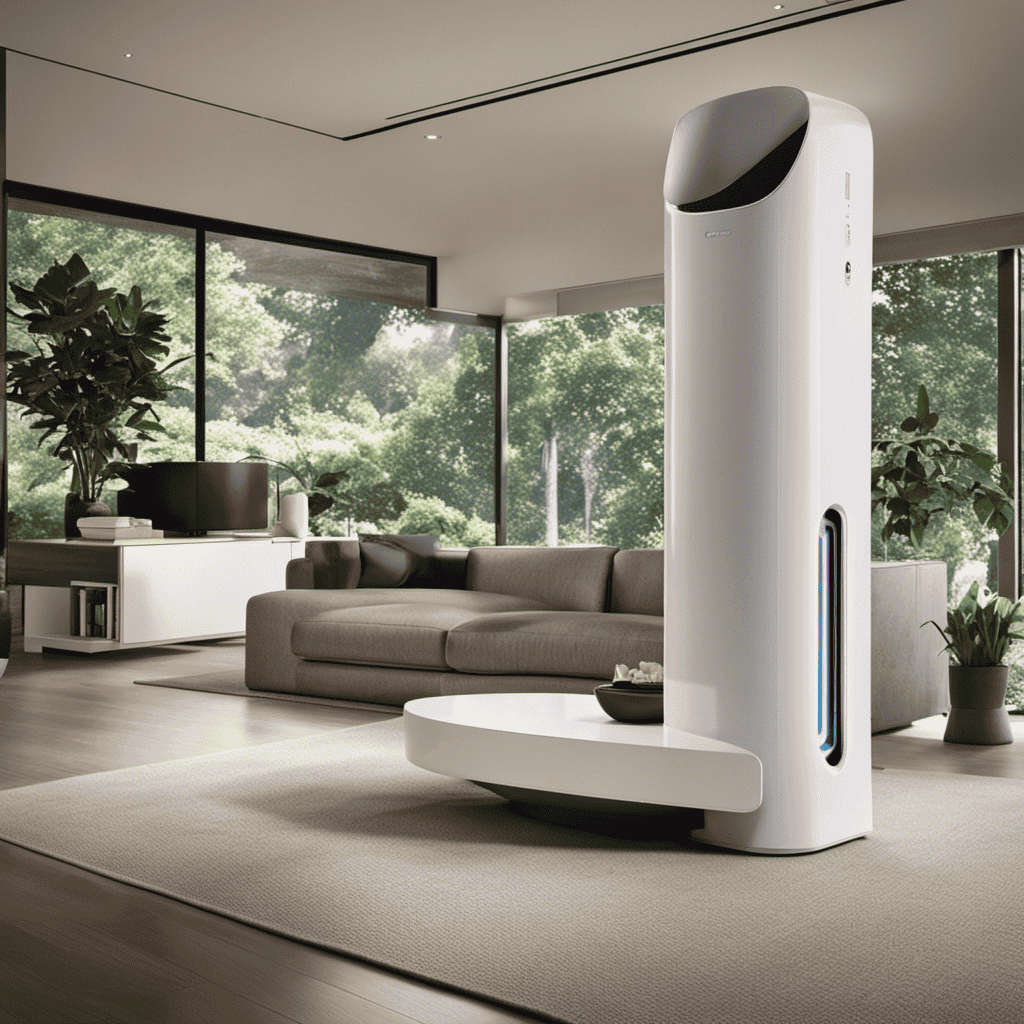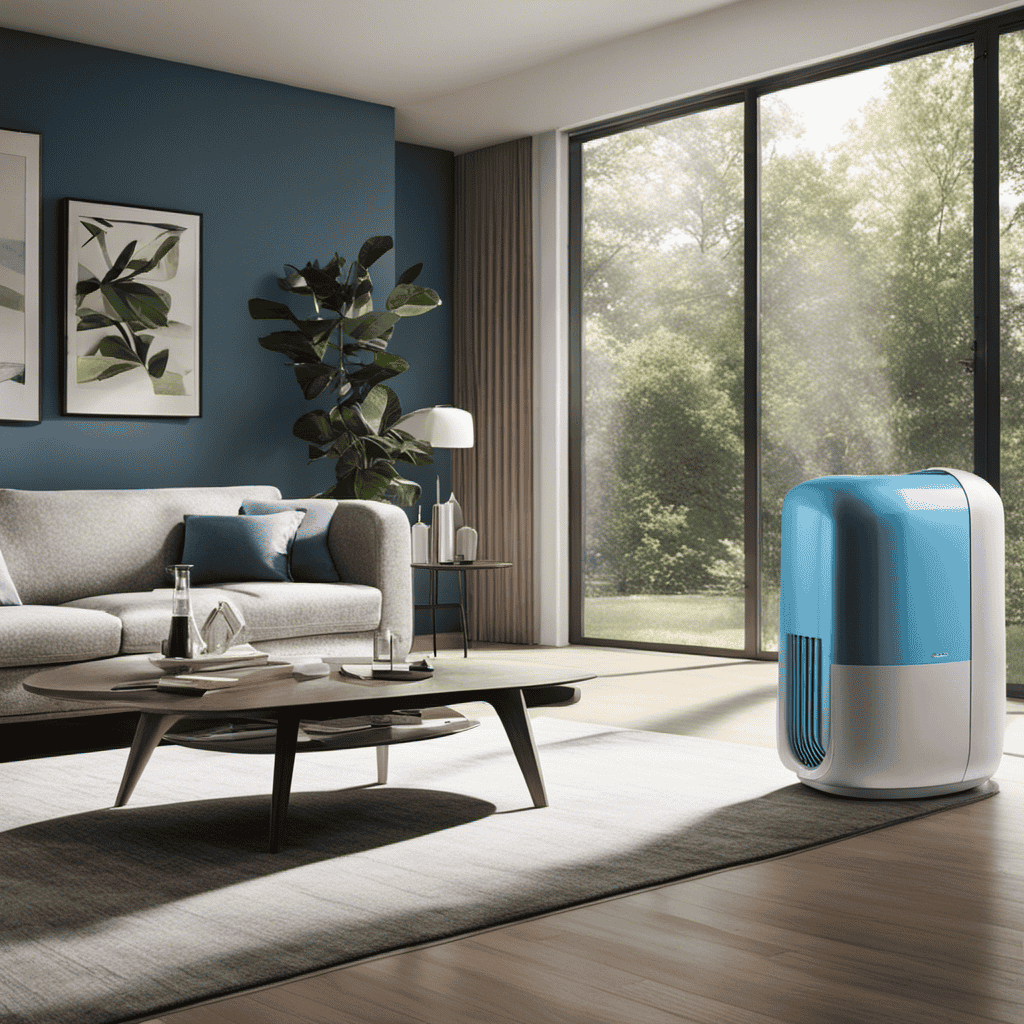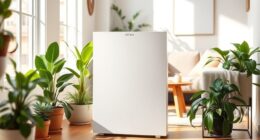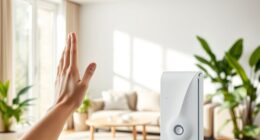Picture yourself inhaling clean and pure air, free from harmful pollutants and allergens. This is precisely what an air purifier provides for you. It’s akin to having your own personal protector, continuously striving to enhance the air quality around you.
In this article, I will explore the benefits of using an air purifier, how they work, and the common pollutants they can remove. By the end, you’ll have all the knowledge you need to choose the right air purifier for your needs and enjoy a healthier indoor environment.
Key Takeaways
- Air purifiers improve indoor air quality by removing harmful particles and pollutants.
- They can reduce health issues like allergies and respiratory problems.
- Air purifiers work through a filtration process that involves mechanical filtration, adsorption, and electrostatic attraction.
- They can remove common air pollutants such as dust, pollen, pet dander, and mold spores.
Benefits of Using an Air Purifier
Using an air purifier can greatly improve the quality of the air you breathe in your home. Indoor air pollution is a serious concern, as it can lead to various health issues such as allergies, respiratory problems, and even asthma.
An air purifier effectively reduces indoor air pollution by removing harmful particles and pollutants from the air. It works by pulling in the air and passing it through a series of filters that capture dust, pet dander, pollen, and other airborne contaminants. These filters are designed to effectively trap even the smallest particles, ensuring cleaner and healthier air to breathe.
Air purifiers have been proven to be highly effective in improving indoor air quality and promoting better respiratory health.
How Air Purifiers Work
When it comes to understanding how air purifiers work, it is important to delve into the air filtration process. This process involves several key steps. These steps include the removal of pollutants through various methods such as mechanical filtration, adsorption, and electrostatic attraction.
Air Filtration Process
The air purifier’s filtration process removes harmful particles from the air. Air purifiers use advanced technology to ensure that the air you breathe is clean and free from pollutants.
One of the key components of an air purifier is the air filter. There are different types of air filters used in air purifiers, each with its own specific function.
The most common types of air filters are mechanical filters, such as HEPA filters, which trap particles like dust, pollen, and pet dander. Activated carbon filters are also commonly used to remove odors and chemicals from the air.
Additionally, some air purifiers use electrostatic filters, which charge particles and attract them to a collection plate. These filters work together in the air purifier’s filtration process to provide you with clean and fresh air in your home or office.
Pollutant Removal Methods
You can rely on different types of filters to remove pollutants from the air. Mechanical filters and activated carbon filters are essential components of air purifiers designed to improve indoor air quality.
Here are three key methods used by air purifiers to remove pollutants:
-
Mechanical filtration: This method involves trapping particles in a filter through a physical barrier. It effectively removes larger particles like dust, pollen, and pet dander.
-
Activated carbon filtration: Activated carbon filters are effective in removing gases, odors, and volatile organic compounds (VOCs) from the air. The carbon absorbs these pollutants, trapping them within its porous structure.
-
Pollutant detection technology: Some air purifiers come equipped with pollutant detection technology. This technology allows them to detect and monitor specific pollutants in the air. It helps the purifier adjust its settings and filtration process accordingly.
With these different types of air purifiers and pollutant removal methods, you can ensure cleaner and healthier indoor air for you and your family.
Health Benefits Explained
By using different types of air purifiers and pollutant removal methods, you’ll experience improved health benefits from cleaner indoor air.
Air purifier effectiveness is measured by its ability to remove pollutants from the air, such as allergens, dust, smoke, and odors. When these pollutants are removed, the air quality in your home or office improves, reducing the risk of respiratory issues and allergies.
Breathing in cleaner air can also have long-term health benefits, such as reducing the chances of developing chronic respiratory conditions and improving overall lung function.
Additionally, air purifiers can help eliminate harmful volatile organic compounds (VOCs) and other chemical pollutants, providing a healthier environment for you and your family.
Now, let’s explore the common air pollutants removed by air purifiers.
Common Air Pollutants Removed by Air Purifiers
When it comes to air purifiers, they’re equipped with advanced filtration systems that are designed to remove harmful particles from the air. These filtration systems are capable of trapping and eliminating various pollutants such as dust, pollen, pet dander, and even mold spores.
Additionally, air purifiers are equipped with odor neutralization capabilities, which help to eliminate unpleasant smells and odors in the surrounding environment.
Lastly, they’re highly effective at removing allergens and dust, making them an essential tool for individuals who suffer from allergies or respiratory issues.
Harmful Particle Filtration
An air purifier can help filter out harmful particles from the air you breathe. It is designed to improve indoor air quality by capturing and removing various pollutants. Here are three ways an air purifier effectively filters harmful particles:
-
HEPA filtration: High-Efficiency Particulate Air (HEPA) filters are capable of trapping particles as small as 0.3 microns. These filters can capture common allergens like dust mites, pet dander, and pollen, as well as fine particulate matter from smoke and pollution.
-
Activated carbon filtration: Air purifiers equipped with activated carbon filters can effectively remove odors and volatile organic compounds (VOCs) from the air. The activated carbon absorbs these chemicals, improving the overall air quality.
-
Pre-filter: Many air purifiers have a pre-filter that captures larger particles such as hair and pet fur. This pre-filter prolongs the lifespan of the main filter by preventing larger particles from clogging it.
Odor Neutralization Capabilities
Activated carbon filters in air purifiers can effectively neutralize odors by absorbing volatile organic compounds (VOCs) from the air. These filters are made from a highly porous form of carbon that has been treated to increase its surface area. This increased surface area allows the carbon to adsorb a wide range of odorous molecules, trapping them within its pores.
When air passes through the activated carbon filter, the VOCs in the air are attracted to the carbon and stick to its surface. This process effectively removes the odors from the air, resulting in a fresher and cleaner environment.
To illustrate the effectiveness of activated carbon filters in odor elimination, consider the following table:
| Odor Source | Odor Intensity (Before) | Odor Intensity (After) |
|---|---|---|
| Pet Odors | High | Low |
| Cooking Odors | Medium | Low |
| Smoke Odors | High | Low |
As shown in the table, activated carbon filters are highly effective at reducing odor intensity, making them a valuable tool for air freshening.
Allergen and Dust Removal
The activated carbon filters in air purifiers can effectively remove allergens and dust particles from the air, improving overall air quality. Here’s how it works:
-
Trapping Allergens: The activated carbon filters have a porous structure that can capture microscopic allergens like pollen, pet dander, and mold spores. This helps reduce allergic reactions and asthma symptoms.
-
Filtering Dust Particles: The filters can also trap dust particles, including fine particulate matter and larger debris. This is especially beneficial for people with respiratory conditions or those living in areas with high pollution levels.
-
Enhancing Air Quality: By removing allergens and dust, air purifiers with activated carbon filters can significantly improve indoor air quality. This is important for maintaining a healthy living environment, especially for individuals with allergies or sensitivities.
To ensure optimal performance, regular air purifier maintenance is essential. This includes cleaning or replacing filters, checking and cleaning the fan, and keeping the purifier in a well-ventilated area. Different types of air purifiers, such as HEPA or ionizers, may require specific maintenance procedures, so it’s important to consult the manufacturer’s guidelines.
Choosing the Right Air Purifier for Your Needs
When choosing the right air purifier for your needs, it’s important to consider factors such as room size and specific air quality concerns.
There are many air purifier brands available on the market today, each with its own unique features and capabilities. Some popular brands include Honeywell, Dyson, and Blueair.
Honeywell air purifiers are known for their advanced filtration systems, which can capture up to 99.97% of airborne particles.
Dyson air purifiers, on the other hand, utilize innovative technology to detect and remove pollutants automatically.
Blueair air purifiers are renowned for their high-efficiency filters, which can effectively remove allergens and contaminants from the air.
When choosing an air purifier, it’s essential to research different brands and models to find the one that best suits your specific needs and preferences.
Maintenance Tips for Air Purifiers
To keep your air purifier functioning efficiently, it’s important to regularly clean or replace the filters as recommended by the manufacturer. Here is a simple air purifier maintenance checklist to help you keep your device in top shape:
-
Clean or replace the pre-filter: This is the first line of defense against large particles like dust and pet hair. Clean it regularly to prevent clogs and ensure proper airflow.
-
Clean or replace the HEPA filter: This is the main filter that captures tiny particles like allergens and pollutants. Clean it if it’s washable or replace it every 6 to 12 months.
-
Clean the exterior: Dust and dirt can accumulate on the surface of your air purifier, affecting its performance. Wipe it down regularly with a damp cloth.
Troubleshooting common air purifier issues:
-
Strange odors: Check if the filters are dirty or need replacement.
-
Weak airflow: Clean or replace the filters and ensure there are no obstructions.
-
Loud noises: Check for loose parts or a clogged filter.
Improving Indoor Air Quality With an Air Purifier
Improve the quality of your indoor air by using an air purifier. Indoor air pollution can have a significant impact on our health, causing respiratory issues, allergies, and other health problems. An air purifier can help remove pollutants and improve the air we breathe. The air purification process involves several steps, including capturing particles, trapping odors, and killing bacteria and viruses. By using filters and technology such as HEPA filters and activated carbon filters, air purifiers can effectively remove dust, pollen, pet dander, smoke, and other pollutants from the air. This helps create a cleaner and healthier indoor environment. Here is a table to highlight the benefits of using an air purifier:
| Benefits | Emotional Response |
|---|---|
| Cleaner air | Relief |
| Reduced allergies | Comfort |
| Eliminated odors | Freshness |
Using an air purifier can greatly improve the air quality in your home, making it a safer and more enjoyable space to live in.
Frequently Asked Questions
How Much Electricity Does an Air Purifier Consume?
An air purifier consumes varying amounts of electricity depending on its size, settings, and usage. It’s important to consider the energy consumption and electricity usage when using an air purifier to make an informed decision.
Can an Air Purifier Remove Odors From the Air?
Yes, an air purifier can remove odors from the air. It uses filters to trap and eliminate particles that cause odors. Regular air purifier maintenance is important for optimal performance. Some of the best air purifier brands include Dyson and Honeywell.
Do Air Purifiers Help With Allergies?
Yes, air purifiers can help with allergies. They can remove pet dander and other allergens from the air, reducing the risk of respiratory illnesses.
Can an Air Purifier Eliminate Mold and Bacteria?
Yes, an air purifier can eliminate mold and bacteria. The elimination process involves capturing and trapping airborne particles, while some models also use UV-C light to kill bacteria. The effectiveness measurement is based on the size of particles it can capture.
Are There Any Health Risks Associated With Using an Air Purifier?
Using an air purifier can have significant health benefits, especially for those living in areas with high air pollution. However, it’s important to note that there may be some health risks associated with long-term exposure to ozone emitted by certain types of air purifiers.
How Does Pm in Air Purifiers Impact Their Functionality?
pm in air purifier explained: PM, also known as particulate matter, plays a crucial role in air purifiers’ functionality. These microscopic particles, such as dust, pollen, and smoke, are captured and filtered through the purifier’s system. With efficient removal of PM, air purifiers improve air quality, minimizing health risks and providing cleaner indoor environments.
Conclusion
After learning about the benefits of using an air purifier and understanding how they work, it is clear that these devices play a crucial role in improving indoor air quality. With the right air purifier, you can breathe easier knowing that harmful particles are being filtered out.
Discovering the common air pollutants that air purifiers remove adds to the importance of these devices. It is surprising to realize that the air we breathe may not be as clean as we think. An air purifier is just one step towards achieving truly pure air.
However, it is important to note that air purifiers are not a cure-all solution. While they can effectively remove many pollutants, there may be other factors contributing to poor indoor air quality. Regular maintenance of the air purifier and addressing other potential sources of pollution are also necessary for optimal results.










